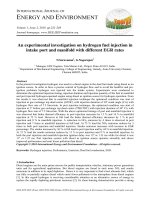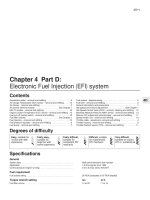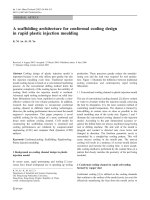Injection molding
Bạn đang xem bản rút gọn của tài liệu. Xem và tải ngay bản đầy đủ của tài liệu tại đây (1.42 MB, 42 trang )
Injection Molding
2.810 Fall 2002
Professor Tim Gutowski
Short history of plastics
1862
1866
1891
1907
1913
1926
1933
1938
1939
1957
1967
first synthetic plastic
Celluloid
Rayon
Bakelite
Cellophane
PVC
Polyethylene
Teflon
Nylon stockings
velcro
“The Graduate”
Outline
Basic operation
Cycle time and heat transfer
Flow and solidification
Part design
Tooling
New developments
Environment
Readings
Tadmore and Gogos
Molding and Casting pp584 -610
Boothroyd Dewhurst
Design for Injection Molding pp 319 - 359
Kalpakjian see Ch 18
Injection molding case study;Washing machine
augers; see on web page
30 ton, 1.5 oz (45 cm3) Engel
Injection Molding Machine
for wheel fabrication
Process & machine schematics
*
*
Schematic of thermoplastic Injection molding machine
* Source: />
Process Operation
Temperature: barrel zones, tool, die zone
Pressures: injection max, hold
Times: injection, hold, tool opening
Shot size: screw travel
Processing window
Temp.
Thermal
degradation
Flash
Shortshot
Melt
Pressure
Typical pressure/temperature cycle
*
*
Time(sec)
Cooling time generally dominates cycle time
tcool
* Source: />
2
(
half thickness )
=
α
α = 10 −3 cm3 sec for polymers
Time(sec)
Calculate clamp force, & shot size
F=P X A = 420 tons
3.8 lbs = 2245 cm3
=75 oz
Actual ; 2 cavity 800 ton
Clamp force and machine cost
Heat transfer
Note; αTool > αpolymer
1-dimensional heat conduction equation :
qx
qx + ∆qx
Fourier’s law
Boundary Conditions:
∂q
∂
( ρ ⋅ c p ⋅ T )∆x∆y = − x ∆x∆y
∂t
∂x
∂T
qx = −k
∂x
∂T
∂ 2T
∂T
∂ 2T
ρ ⋅ cp
= k 2 or
=α 2
∂t
∂x
∂t
∂x
1st kind
2nd kind
3rd kind
T ( x = x' ) = constant
∂T
( x = x' ) = constant
∂x
∂T
−k
( x = x' ) = h (T − T∞ )
∂x
−k
The boundary condition of 1st kind applies to injection molding since the
tool is often maintained at a constant temperature
Heat transfer
Tii
t
TW
-L
x
+L
Let Lch = H/2 (half thickness) = L ; tch = L2/α ;
∆Tch = Ti – TW (initial temp. – wall temp.)
T − TW
x
α ⋅t
; ξ = + 1; FO = 2
Non-dimensionalize: θ =
Ti − TW
L
L
Dimensionless equation:
Initial condition
Boundary condition
Separation of variables ;
matching B.C.; matching I.C.
∂θ
∂ 2θ
= 2
∂FO ∂ξ
FO = 0
θ =1
ξ =0
ξ =2
θ =0
θ =0
θ (ξ , FO ) = ∑ f ( FO ) g (ξ )
Temperature in a slab
Centerline, θ = 0.1, Fo = αt/L2 = 1
Bi-1 =k/hL
Reynolds Number
Reynolds Number:
V2
ρ
inertia
ρVL
L
Re =
=
V
µ
µ 2 viscous
L
For typical injection molding
ρ = 1 g cm3 = 103 N m 4 s 2 ; LZ = 10 −3 m thickness
V≈
−1
Part length 10
=
;
Fill time
1s
For Die casting
µ = 103 N ⋅ s m 2
3 ⋅103 ×10 −1 ×10 −3
Re ≈
= 300
−3
10
* Source: />
Re = 10 −4
Viscous Shearing of Fluids
F
v
F/A
v
τ =µ
h
µ
h
1
F v
∝
A h
v/h
Newtonian Viscosity
Generalization:
τ = µγ
τ
= η (γ )
γ
γ : shear rate
Injection molding
“Shear Thinning”
~ 1 sec-1 for PE
γ
Typical shear rate for
Polymer processes (sec)-1
Extrusion
Calendering
Injection molding
Comp. Molding
102~103
10~102
103~104
1~10
Viscous Heating
P
F ⋅v F v
v
=
= ⋅ = µ
Vol Vol
A h
h
Rate of Heating
= Rate of Viscous Work
Rate of Temperature rise
Rate of Conduction out
ρ ⋅ cp
dT
v
= µ
dt
h
2
or
dT
µ
=
dt ρ ⋅ c p
2
v
h
2
dT
k d 2T
k ∆T
=
~
dt ρ ⋅ c p dx 2 ρ ⋅ c p h 2
Viscous heating µv 2
=
Conduction
k∆T
Brinkman number
For injection molding, order of magnitude ~ 0.1 to 10
Non-Isothermal Flow
Flow rate: 1/t ~V/Lx
v
Heat transfer rate: 1/t ~a/(Lz/2)2
Flow rate
V ⋅ L2z
1 VLz Lz
~
=
⋅
Heat xfer rate 4α ⋅ Lx 4 α Lx
Small value
=> Short shot
For injection molding
Flow rate
1 10cm / s × 0.1cm 0.1cm
~
⋅
= 2.5
−3
2
Heat xfer rate 4 10 cm / s
10cm
For Die casting of aluminum
Flow rate
1 10cm / s × 0.1cm 0.1cm
−2
~
⋅
≅
10
Heat xfer rate 4 0.3cm 2 / s
10cm
* Very small, therefore it requires thick runners
Injection mold
die cast mold
Fountain Flow
*
**
* Source: ; ** Z. Tadmore and C. Gogos, “Principles of Polymer Processing”
Shrinkage distributions
sample
Transverse direction
V=3.5cm/s
V=8cm/s
* Source: G. Menges and W. Wubken, “Influence of processing conditions on Molecular Orientation in Injection Molds”
Gate Location and Warping
Sprue
2.0
60°
2.0
Before shrinkage
1.96
Shrinkage
Direction of flow – 0.020 in/in
Perpendicular to flow – 0.012
60.32°
1.976
After shrinkage
Air entrapment
Gate
Center gate: radial flow – severe distortion
Diagonal gate: radial flow – twisting
Edge gate: warp free, air entrapment
End gates: linear flow – minimum warping
Effects of mold temperature and
pressure on shrinkage
LDPE
LDPE
0.030
PP
0.025
Acetal
0.025
0.020
Nylon 6/6
0.020
Shrinkage
Shrinkage
0.030
0.015
0.010
0.015
Acetal
PP with
flow
PP across
flow
0.010
0.005
0.005
Nylon
6/6
PMMA
PMMA
0.000
0.000
100
120
140
160
180
200
Mold Temperature (F)
220
240
6000
10000
8000
14000
12000
18000
16000
Pressure on injection plunger (psi)
Where would you gate this part?
Weld line, Sink mark
Gate
Weld line
Mold Filling
Solidified part
Sink mark
* Source: />
Basic rules in designing ribs
to minimize sink marks
Injection Molding
*
*
* Source: />









